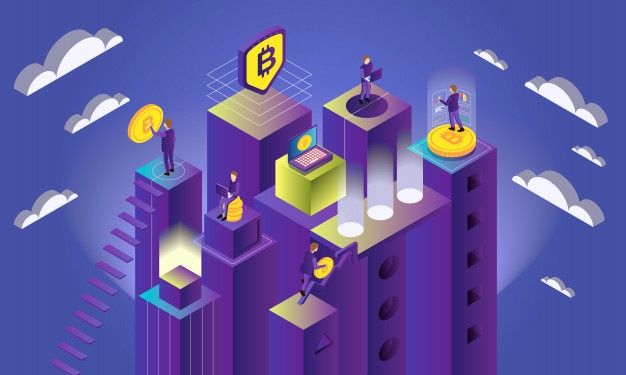The verification process in blockchain and validation for each block
The verification of blockchain includes (of transactions) security, super durable records, irreversible, and kept up with as a public ledger. Perhaps the best element is that they have no obstruction of any outsider. This load of qualities has made blockchain so promptly versatile.
How might we accomplish Blockchain confirmation?
Blockchains comprise code blocks connected together and are reliant upon the understanding between parties where the exchange is going on. There are various hubs of such sort of nonstop blockchains on the blockchain network. It works as a decentralized record. At whatever point another block is made, the exchange gets a computerized signature finger impression that can’t be changed and contains hashtag capacities from the previous block with a one-of-a-kind yield. At the point when the yield is changed without being checked, the exchange holds no legitimacy and becomes unconfirmed. This infers that when the hash is executed, all network hubs should get a similar outcome. The exchange is approved if the modification finishes this assessment.
The essential qualities of blockchains are security, unchangeable records, and checks. The different squares are connected together by connecting hashtags, and each block contains the hash code of the past block, which is obtained from the qualities delivered when the new block comes up.
Every exchange that is started requires the associated nodes to approve the below mentioned;
- The historical backdrop of exchange is not relevant. Likewise, the equilibrium of the sender’s wallet address is checked.
- The beneficiary’s location is likewise approved.
On the off chance that these measures are met definitively, the solicitation is allowed. The solicitation and the exchange’s novel private keys consolidate to make a computerized verification signature. Then, this is sent and affirmed across all network hubs for key and mark coordinating with utilizing an output muddled hashing calculation made with the solicitation by a nonce. Nodes battle with each other to settle the hash, ensuring the blockchain check process twice.
One should remember that the nodes are connected and are mini high-end setups that can answer the code referenced above for the right outcome. They additionally broadcast the result to the organization’s other executing miner hubs to check that the arrangement is right. This ensures that all nodes are constantly observing the transactions and that they are openly approved.
It ought to be remembered that a block might incorporate countless transactions. Just the executing hub that checks the exchange gets compensated miners, setting up a fool-proof blockchain confirmation system with sound mining fulfillment. Any blunder in calculation will refute the exchange spread across completely connected hubs. For instance, on the Bitcoin blockchain network, mining rewards are regularly Bitcoin or Ethereum. All things considered, hubs mine the data and get their award, a transaction becomes affirmed, approved, and wrapped up.
How Are Blockchain Transactions Validated?
Blockchain Validators
A Blockchain Validator is somebody who is responsible for approving transactions on a blockchain. By working full-node on the Bitcoin Blockchain, each member might turn into a blockchain validator. Nonetheless, the principal motivation to work a total node is to further develop security. Lamentably, since this is an intangible motivating force, it is deficient to convince somebody to work a total node. Subsequently, Blockchain Validators are for the most part miners and mining pools that work total nodes.
Separating between Blockchain Validation and Blockchain Consensus
It is basic to comprehend that the expressions “approval” and “agreement” are not equivalent. A Blockchain Validator approves transactions by guaranteeing they are legal (not noxious, twofold spends, and so on)
Then again, the agreement characterizes the requesting of events on the blockchain — and agreeing on that request.
The agreement basically involves concurring on the succession of confirmed transactions.
The approval precedes the agreement.
Is Blockchain the new key to high efficiency for startups? Full Story Read Here:
How Are Blockchain Transactions Validated?
At whatever point an exchange happens, it is communicated to the entire network. Excavators take a few transactions, check “real,” and spot them into a square subsequent to hearing the broadcasts.
Be that as it may, excavators “hear” different transactions on various occasions (because of latency issues, and so forth) Besides, contingent upon transaction costs, they might pick different transactions to place in their block. Subsequently, every excavator is developing their block. Furthermore, his block might be altogether not quite the same as the remainder of the miners of the network.
Isn’t it genuine that everybody is developing with different blocks? Then, at that point, how are we going to concede to a unique common ledger!?”
That is one of the convention’s most engaging components. Miners are not needed to build a similar worldwide block. All things considered, they may each make their block, which will be totally separate transactions. What’s more, the members will come to an “agreement” on which block will be added straight away.
A miner might have a block that contains every genuine exchange, yet his square might in any case fail to agree. In the event that someone else is picked, he will assemble another block and attempt once more.
PoW and PoS are strategies for figuring out which hub gets the mining reward.
Mining might be extremely worthwhile.
That is the reason a blockchain network has more than one miner. Maybe, numerous diggers seek the mining prize.
Subsequently, blockchain technology networks should incorporate an agreement system that figures out which miner receives the reward ultimately. Many methodologies might be taken:
Proof of-Work
The PoW reward system is broadly used in bitcoin networks. Moreover, PoW is utilized by both the Bitcoin and networks of Ethereum.
At the point when another square is required, all excavators in the organization start chipping away at the hash issue. The mining reward is given to the digger who settles it first. It’s pretty much as simple as first starting things out.
Point of-Stake
PoS and PoW have a similar objective: to approve transactions by creating another hash.
In a PoS framework, be that as it may, hubs are not competing for the mining reward. All things being equal, only one node is picked to check the following hash. The extravagance of the hub – or, as such, its stake in the organization – is the choice rule.
Subsequently, since only one hub is occupied with addressing the numerical issue in a PoS-based organization, energy utilization will be comparatively lower.
Moreover, the motivating force in a PoS framework isn’t paid in newly made currency forms. All things being equal, the picked node will be paid a transaction charge. At the point when the organization is set up, all coins are readily issued. Thus, hubs that find another hash in a PoS framework are alluded to as “forgers” instead of “miners.”
There are different strategies for approving transactions.
- Proof-of-Authority
- Proof-of-Burn
- Proof-of-Capacity
- Proof-of-Elapsed Time.
In principle, these frameworks have a similar objective: to approve new information on the network. Just how the miners are picked will differ.
Final Word
As should be obvious, agreement methods are chiefly concerned about arriving at an agreement on the sequencing of event transactions (and who will add them). The miner approves the transactions before they are incorporated into the block. At the point when the miners make the block, while the Blockchain Validators guarantee that it is genuine. In case the agreement is accomplished, the network might continue to the next block.



